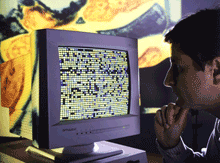Research Matters
December 8, 2008 Gene Activity Can Predict Survival Rates of Patients with LymphomaA new study shows that gene activity can be used to predict survival rates of people with a type of non-Hodgkin’s lymphoma called diffuse large B-cell lymphoma (DLBCL). The method can potentially be used to guide treatment and to help develop future therapies.  A scientist examines DNA microarray data. Image courtesy of Wellcome Library, London. All rights reserved by Wellcome Images.
DLBCL is a cancer of white blood cells, or lymphocytes, which normally help destroy bacteria, viruses, and other infectious agents invading the body. Although DLCBL cells tend to look the same under the microscope, recent studies have shown that they can vary at the molecular level, solving the mystery of why many patients don’t respond to standard chemotherapy. DNA microarray technology has made it possible to analyze the activity of thousands of genes at once in order to establish their pattern of activity, or gene expression signature. A research team led by Dr. Louis M. Staudt of NIH’s National Cancer Institute (NCI) used this technology to measure the activity of thousands of genes in tumor biopsy samples from 414 newly diagnosed patients before treatment. Of these patients, 181 received the standard DLBCL chemotherapy regimen, called CHOP (cyclophosphamide, hydroxydoxorubicin, oncovin and prednisone). Another 233 patients received CHOP along with a therapeutic antibody called rituximab, which binds to the surface of malignant cells—a regimen known as R-CHOP. The results, published in the November 27, 2008, issue of the New England Journal of Medicine, showed that 3 gene expression signatures—called germinal-center B-cell, stromal-1, and stromal-2—predicted survival in DLBCL patients for both treatment regimens. The germinal-center B-cell and stromal-1 signatures were associated with increased survival, and the stromal-2 signature was associated with reduced survival. The germinal center B-cell signature is expressed by malignant cells in the tumors. The stromal signatures, in contrast, reflected the activities of non-malignant cells in the tumor’s microenvironment. Stromal-1 genes encode for proteins that make up or modify the extracellular matrix—the molecular matrix found outside of cells. Stromal-2 genes encode proteins involved in the formation of new blood vessels, or angiogenesis. Currently, the International Prognostic Index (IPI) is used by physicians to evaluate patients with DLBCL. IPI is based on clinical factors such as age, stage of the tumor, and whether cancer has spread to other parts of the body. Combining a model using the 3 gene signatures with the IPI improved the predictive power of both models. The researchers hope these new findings will help to increase survival rates in DLBCL patients. “Our findings reveal new biological variations in DLBCL that influence whether a patient is likely to be cured by chemotherapy and provide many fresh ideas about how existing drugs might be utilized to overcome the remaining resistance of some DLBCL tumors to our current therapy,” Dr. Staudt said. Related Links:
Gene Activity Can Predict Survival Rates of Patients with Lymphoma This page was last updated
December 8, 2008
.
|



